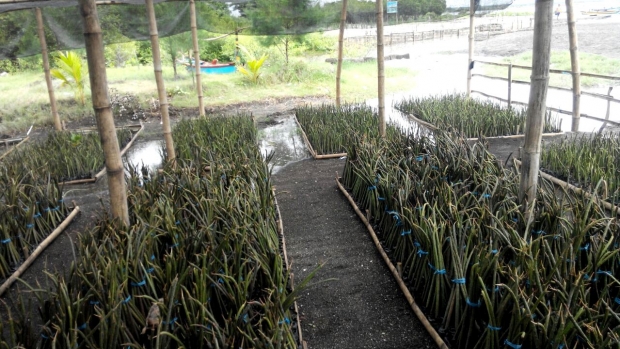Grants :: Small Grant Facilities :: Awareness Raising and Economic Improvement of Coastal Communities through Mangrove Planting
Awareness Raising and Economic Improvement of Coastal Communities through Mangrove Planting

Mangrove Nursery Site, Curah Dringu and Dungun village, Probolinggo, East Java, Indonesia © ISES
Objectives
The project objective is to protect mangrove ecosystem in Curah Dringu Village through mangrove planting, public awareness and livelihood activities.
Background
Coastal abrasion has continually occurred in Curah Dringu Village, Tongas District, Probolinggo. It resulted negative impacts, among others affects community's farmlands and fish-ponds, lost of biodiversity, etc. Farmer group who lives in this village has initiated to reduce the abrasion by planting mangrove and coastal vegetation since 2013. The rehabilitation activity resulted a good impact which reduce the intensity of coastal abrasion, yet at some point this activity has not yet been optimum due to financial shortage and many other areas along Tongas coast remain barren.
As a matter of fact, Tongas has beautiful landscape and has enormous potential for ecotourism. Visitors have visited this area for bird watching and seeing some rare animals. This potential gradually fades away and people are not aware of this. The level of public awareness in maintaining, managing and preserving coastal ecosystem in this village has decreased. Through the MFF- SGF project, the Institute for The Study and Empowerment of Society (ISES) in collaboration with community groups tries to expand mangrove forest in Tongas. A farmer group, consisting of 15 (fifteen) members plans to rehabilitate 3 ha degraded area through mangrove and coastal vegetation planting. The project will also involve women's group to improve their capacity in mangrove-based food processing.
Target beneficiaries
Direct beneficiaries reached up to 118 people that included the group members along with their family members (43% females and 57% males), and indirect beneficiaries were approximately up to 2,048 people (where the ratio between male and female communities was almost 1:1 balanced).
Outputs
Farmer group had grown 40,000 mangrove seedlings in the nursery. Then along with the other local communities, they planted the mangrove seedlings (Rhizopora Mucronata) and 500 casuarina seedlings along the coastlines at Curah Dringu village. Around 5 ha areas were restored with 80% survival rate of seedlings planted.
Two groups were formed during the project implementation. Besides taking part in the rehabilitation activities, the group members received training on mangrove and fisheries-based food processing and organizational management. Training on mangrove-based product (making flour from Bruguiera) and fish cracker was conducted in September 2016, and training on product packaging and marketing was conducted in November 2016.
Through the community empowerment program, the women's groups could produce fish crackers, sticky rice crackers, and shrimp/crab paste. Addition income generated by the groups was estimated more than IDR 2 million per month. The next step, this small scale business would be registered to be one of the village-owned enterprise (Bumdes).
In terms of advocacy, ISES had succesfully promoted and strengthened coastal protection policy at the local level. ISES together with the community groups developed draft village regulation.
Accomplishments and challenges
 |
Contributions to cross-cutting themes
The project rationale is designed to mitigate sea abrasion and it does have an impact to climate change. By planting 40,000 mangrove seedlings and 500 coastal vegetation (Casuarina), there will be additional carbon stock above ground.
Gender has been considered as priority and reflected in project activities. About 20%, women was clearly seen in the participation of establishing mangrove nursery. Also, community group members that involved in capacity building program are 100% women.
Lessons Learned
- While choosing the types of livelihood activities to be conducted, it is best to use participatory approach, where grantee has gone through consultation process with the communities as the implementers on the ground. In addition, it is important to identify the all supporting aspects related to the livelihood activities/small-scale business starting from the provission of the raw materials, production, marketing to the management of the profit generated and cash flow to ensure the sustainability of the business.
- Especially for the mangrove-based food training and production, grantee should make sure the availability of the mangrove species needed as the main ingredients/materials for the training and production in order to ensure sustainability of the business. It should be noted that not the all mangrove fruits, leaves and so forth can be harvested and available throughout the year.
- Good communication with the local government will secure the land use for rehabilitation site (through the development of village regulation) in a long period of time and give full access to grantee/community organization to manage the area.
Project Facts
Country
Location
Curah Dringu and Dungun village, Probolinggo, East Java
Topic
Duration
2nd Mar 2016 to 31st Dec 2016
MFF Grant Amount
IDR 160,000,000
Co-financing Partner
In kind from others IDR 3,100,000 (USD 254.10)
In kind from Grantee IDR 12,400,000 (USD 1,016.40)
Implementing Partner
ISES (Institute for The Study and Empowerment of Society)
Kotaanyar Village RT 24 RW 07 Kotaanyar Sub-District, Probolinggo, East Java 67293
Contact Person:
Agus Sukipyo, SHI., S. Pd.
+6282332573215
Email address: agussukipyo@gmail.com